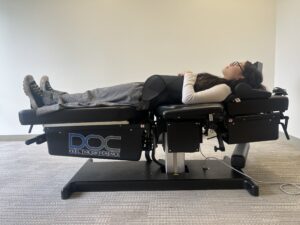Do I Have Sacroiliac (SI) Joint Dysfunction?
Sacroiliac joint dysfunction is a condition characterized by the improper movement of the SI joint. It usually begins with the instability of the pelvis and low back. Pain can radiate from the back to the legs and imitate sciatic nerve pain. The pain caused by this condition is called sacroiliac joint pain.
It’s a quite common condition, as it is estimated that 15 – 30% of all lower back pains are caused by dysfunction of the sacroiliac joint (SI joint). It’s more common in young and middle-aged women.
Anatomy of SI joint
The sacroiliac joint is localized in the lower back, on both sides of the spine. It connects the iliac (hip) bones with the sacrum (bone at the bottom of the spine). The joint is reinforced by strong ligaments and muscles, which provide support and limit the joint motion.
SI joint has very little motion, and is responsible in forward/backward bending and allows twisting of the pelvis during walking. Acts as shock absorber protecting the spine, and its main function is to provide stability of the upper body and to transfer the weight of the upper part of the body, while walking and standing, through the pelvis to the legs.
Why Does SI Joint Pain Occur?
Just as other joints in the body, SI joint can be damaged by inflammation, aging, wear
- Injury – low or high energy trauma
- Pregnancy and labor
- Sacroiliitis – inflammation of the SI joint.
- Altered walking pattern by any condition
- Infection – very uncommon, but very serious condition
- Rheumatoid Disease
- Osteoarthritis – the cartilage between the bones is damaged and they begin to rub on each other, and degenerative arthritis occurs.
Having in mind what is stated before, risk factors include:
- Age
- Sex – females are more prone to this condition
- Pregnancy and natural delivery
- Obesity
- Heavy lifting
- Hip injuries from car accidents and falls
- Sports that put pressure on the hips
- Knee pain – as it is associated with altered walking pattern
- Other diseases that affect bones and joints such as rheumatoid diseases
- Repetitive stress movements
How Does Sacroiliac Joint Pain Start?
Although SI joints have very little motion, whenever dysfunction occurs, that motion is affected. And dysfunction usually is manifested with:
- Hypomobility (fixation) – too little movement in the SI joint and muscle tension, lower back pain and difficulty in the motion are present or
- Hypermobility (instability) – is presented with too much movement in the SI joint which make pelvis to feel unstable, and pain can be present too.
Symptoms include:
- Pain – manifested as lower back pain or pain in the buttocks, but it can radiate to hips and groin. It’s chronic and severe and is worsening while climbing the stairs or running. Worse at the morning. Usually felt on one side, but can be felt on both sides.
- Sciatic Nerve Pain – feels sharp and hot, it’s spread on the back of thighs, but almost never spread below the knee.
- Instability of pelvis– felt during walking, climbing, standing.
How Is It Diagnosed?
In order to diagnose dysfunction of the SI joint, multiple tests are needed. Diagnosis can be difficult, because the symptoms are present in other conditions too. SI joint dysfunction often is misdiagnosed with sciatic nerve pain and discus hernia.
Our San Francisco Chiropractor will start the diagnosis process with medical history questions and physical examination. Information about symptoms and recent injury or pregnancy have a
Our doctors may also manipulate your hips or pelvis in order to feel the instability or fixation of the joint. Some of the orthopedic tests used to identify SI joint dysfunction are:
- Sacral thurst test
- Distraction test
- FABER test
- Palpation test
Additional tests that can be used are SI joint injection and imaging test like, X-ray, MRI, CT or ultrasound.
SI joint injection is the
Diagnostic imaging tests are used to look up for other structural causes for pain, or signs for other bones or joints diseases.
Want to learn more about joint symptoms and treatment? We’ve selected some helpful resources for you.
SI Joint Treatment
When talking about the treatment for the sacroiliac joint dysfunction, it is very important to understand that although symptoms can be treated and further worsening can be prevent, the condition itself is not always curable.
Treatment options include:
- Bed rest
- Cold or heat therapy
- Pain-relievers
- Anti-inflammatory medications
- Physical therapy
- Manual manipulation
- SI injections
- Braces
- Nerve treatment
- Surgical treatment
These options usually are combined, but generally speaking, which treatment option will be used depends from the process inside the joint. For example, if inflammation is present, corticosteroid injection will be used, and if the problem is in surrounding ligaments and muscles, physical therapy will be used.
Most commonly used pain relievers are acetaminophen and NSAIDs (non-steroid anti-inflammatory drugs) such as ibuprofen. Muscle relaxants can also be used.
Physical therapy typically include stretching to reduce tension and spasms in hip muscles, strengthening exercises to provide better support for the pelvis and aerobic exercises that increase oxygen levels in tissues, which helps with faster healing.
Manual manipulation consists of physical adjustments and corrective exercises that improve SI joint motion and reinforce the muscles and ligaments. The main goal is restoring the normal range of motion and reducing muscle tension. It can be provided by an SF chiropractor, physical therapist or other qualified healthcare providers.
When pain is very severe or is limiting the physical therapy, local anesthetic can be injected in the joint. Usually the local anesthetic is injected in combination with some corticosteroid, to reduce the inflammation as well.
When hypermobility of the pelvis is present, a pelvis brace can be used. The brace is in a shape of wide belt.
From all above we can easily conclude that the spectrum of treatments for SI joint dysfunction is very wide. But, not every treatment will work on every patient. So it is important to try different treatments until you find the one that is right for you.
Can A Chiropractor Help Me?
Chiropractic care usually is part of the first line treatment for SI joint pain. The reason for this is that chiropractor can help you with reducing the pain and improve mobility of affected joint. Variety of chiropractic methods can help you with SI joint dysfunction.
The chiropractor knows that different approaches work for different patients and may adopt different manipulations to treat a patient with SI joint dysfunction. There are two general approaches for this condition: spinal manipulation and spinal mobilization, and the chiropractor will estimate which is the best for you.
Prevention Is Always Easier
Sacroiliac joint dysfunction is condition that can easily be prevented by reducing the risk factors. Prevention activities include:
- Proper lifting techniques
- Good posture
- Corrective exercise
- Good nutrition
- Healthy weight
To get to the root cause of pain and discomfort, schedule an initial consultation, including a comprehensive evaluation and first treatment.



